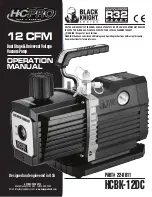
6
484 01 3600 00
Pitch condensate line 1 inch (25.4 mm) for every 10 ft. of
length to an open drain or sump. Make sure that the outlet
of each trap is below its connection to condensate pan to
prevent condensate from overflowing the drain pan. Prime
all traps, test for leaks, and insulate traps and lines if located
above a living area.
3” / 76mm
A08067X
Figure 6
−
Condensate Trap
NOTE
: If unit is located in or above a living space, where
damage may result from condensate overflow, a
field
−
supplied, external condensate pan should be installed
underneath the entire unit, and a secondary condensate line
(with appropriate trap) should be run from the unit into the
pan. Any condensate in this external condensate pan
should be drained to a noticeable place. As an alternative to
using an external condensate pan, some localities may
allow the running of a separate 3/4 inch (19 mm)
condensate line (with appropriate trap) per local code to a
place where the condensate will be noticeable. The owner
of the structure must be informed that when condensate
flows from secondary drain or external condensate pan, the
unit requires servicing or water damage will occur. To further
protect against water damage, install a float switch to shut
the unit off if the water in the secondary pan gets too high.
NOTE
: To avoid drainage problems, test the primary drain
line by slowly pouring water into the pan. Check piping for
leaks and proper condensate drainage. Using the
secondary drain as explained in the previous note provides
further protection against overflow due to a clogged primary
drain.
NOTE
: In applications where return air humidity levels stay
at 70% or above for a prolonged period of time,
condensation can form on the bottom of pan and drip.
WASTE LINE CONNECTION
If the condensate line is to be connected to a waste (sewer)
line, an open trap must be installed ahead of the waste line
to prevent escape of sewer gases (See Figure 7).
A10216
Figure 7
−
Condensate Drain to Waste Line
EXPLOSION HAZARD
Failure to follow this warning could result in personal
injury or death.
Provide trap with air gap in drain line when connecting
to waste (sewer) line.
!
WARNING
Humidifier Application
When installing a humidifier in a system which contains an
N
−
coil, consideration must be given to location of coil slabs.
See Fig. 8.
1. The humidifier should be mounted to the supply
plenum or return duct whenever possible. If
necessary, humidifiers can be mounted to the left side
of coil casing. The right side of the coil casing must
not be used to mount the humidifier.
2. Care must be taken to prevent damage of N
−
coil
when attaching humidifier to coil casing or plenum.
3. Ensure that humidifier has adequate airflow.
Supply
Evaporator
N-Coil
Upflow
Furnace
A05414
Figure 8
−
Installation of Humidifier in System with
N
−
Coil

























